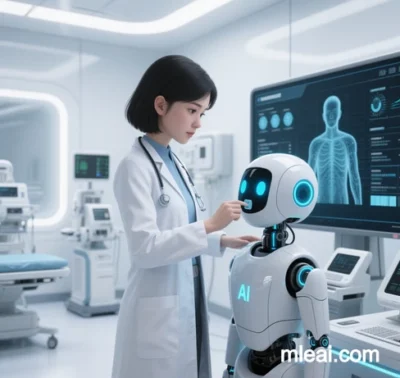
Integration of MLOps and AI in Healthcare: A Comprehensive Analysis (2025 Update)
I. Technical Architecture
1. Medical Data Engineering
MLOps in healthcare focuses on building domain-specific data infrastructure:
- Multimodal Data Lakes: Integrate EHRs, DICOM images, wearable device streams, genomic data, and surgical robot logs using Delta Lake for petabyte-scale management.
- Dynamic Data Cleansing: Knowledge graph-based auto-labeling resolves missing spatiotemporal context (e.g., “blood glucose 8.6mmol/L postprandial”), improving labeling efficiency.
- Privacy-Preserving ETL: Homomorphic encryption enables secure cross-border clinical trial data sharing without exposing raw information.
2. Medical Model Factory
Specialized ML requirements for healthcare:
- Cross-Modal Alignment: CLIP-like architectures align pathology slides with reports, achieving high diagnostic accuracy.
- Temporal Event Modeling: Transformer-XL processes ICU monitoring data for early sepsis prediction.
- Few-Shot Learning: Meta-learning frameworks enable rare disease diagnosis with minimal samples.
3. Medical AI Operations
Novel MLOps practices for reliability:
- Drift Detection: Monitors CT hardware-induced feature shifts and triggers model retraining.
- Explainability-as-a-Service: SHAP/LIME integration meets FDA transparency requirements.
- Disaster Recovery: Simulates network outages to ensure surgical navigation systems operate with low latency.
II. Key Applications
1. Intelligent Diagnostics
- Imaging-as-Code: DAG-based pipelines integrate DICOM preprocessing, lesion segmentation, and malignancy prediction, reducing false positives in lung nodule diagnosis.
- Multimodal Fusion: Graph neural networks combine ECG, ultrasound, and lab data to improve myocardial infarction detection.
2. Personalized Therapeutics
- Dynamic Treatment Optimization: Reinforcement learning adjusts chemotherapy dosing to reduce side effects while maintaining efficacy.
- Surgical Robotics: Imitation learning extracts expert strategies from robotic logs, enhancing novice surgeon performance.
3. Drug Development
- Molecular Generation: Diffusion models accelerate Alzheimer’s drug discovery by generating novel Tau inhibitors.
- Virtual Trials: Digital twins predict drug responses, reducing Phase II trial sample sizes.
III. Challenges and Solutions
1. Data Limitations
- Synthetic Data: Conditional GANs generate annotated pathology slides matching real-data performance.
- Federated Learning: Trains diabetic retinopathy models across hospitals without sharing raw data.
2. Real-Time Computing
- Photonics Acceleration: Reduces power consumption for portable ultrasound analysis.
- Quantum Encoding: Enhances tumor mutation detection speed using quantum entanglement.
3. Regulatory Compliance
- Dynamic Auditing: Verifies AI decisions against FDA/NMPA guidelines in real time.
- Blockchain Traceability: Immutably records model lifecycle data for audits.
IV. Emerging Frontiers
1. Self-Evolving Systems
- Neuro-Symbolic AI: Combines transformers with medical knowledge graphs for explainable decision support.
- Generative Assistants: Multimodal GPT models streamline diagnosis by integrating imaging, literature, and patient interaction.
2. Quantum-Enhanced AI
- Radiotherapy Optimization: QAOA algorithms on quantum computers improve dose distribution accuracy.
- Drug-Target Simulation: Quantum chemistry tools predict binding free energies with high precision.
3. Metaverse Interfaces
- Mixed-Reality Navigation: Projects AI-reconstructed 3D vasculature via HoloLens, shortening complex surgeries.
- Haptic Feedback: Enables remote procedures with submillimeter accuracy using force-sensing gloves.
V. Ethical and Industry Impact
1. Human-AI Collaboration
- Tiered Autonomy: Classifies decisions into routine (AI-driven), complex (AI-assisted), and critical (human-led).
- Performance Metrics: Quantifies AI’s role in care delivery through replacement and enhancement rates.
2. Healthcare Ecosystem Shift
- MLOps Providers: Offer end-to-end services from data labeling to regulatory compliance.
- Insurance Innovation: Digital twin-based risk assessment transforms actuarial models.
Conclusion
The fusion of MLOps and AI is redefining healthcare across three dimensions:
- Technical Depth: Transitioning from algorithm-centric to system-level MLOps.
- Clinical Value: Shifting focus from treatment to prevention, reducing costs.
- Industry Landscape: Spurring new infrastructure like medical AI factories and quantum biotech centers.
The critical challenge lies in establishing trustworthy medical AI, requiring excellence in performance (AUC >0.95), explainability, and robustness. Advancements in neuromorphic chips and DNA storage are paving the way for microwatt-level, bio-integrated AI systems, potentially enabling implantable diagnostic devices.
Data sourced from publicly available references. For collaborations or domain inquiries, contact: chuanchuan810@gmail.com.





